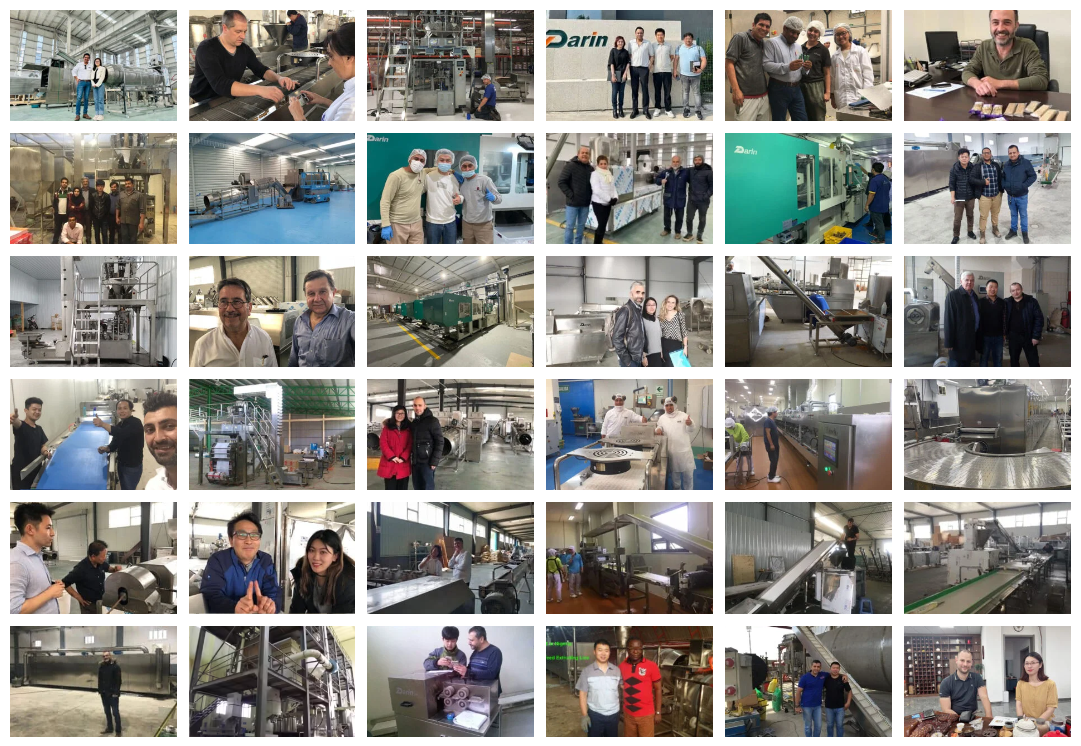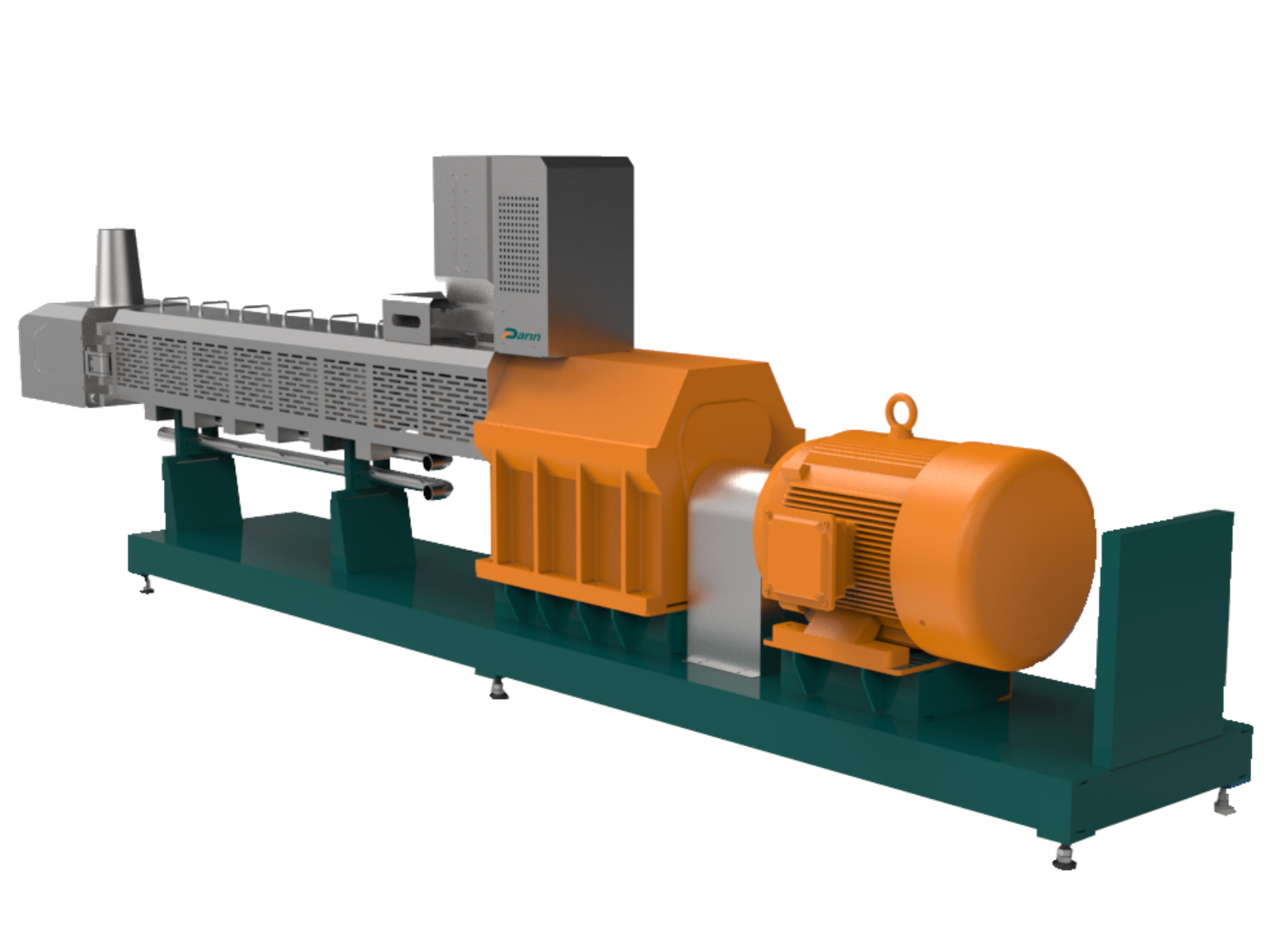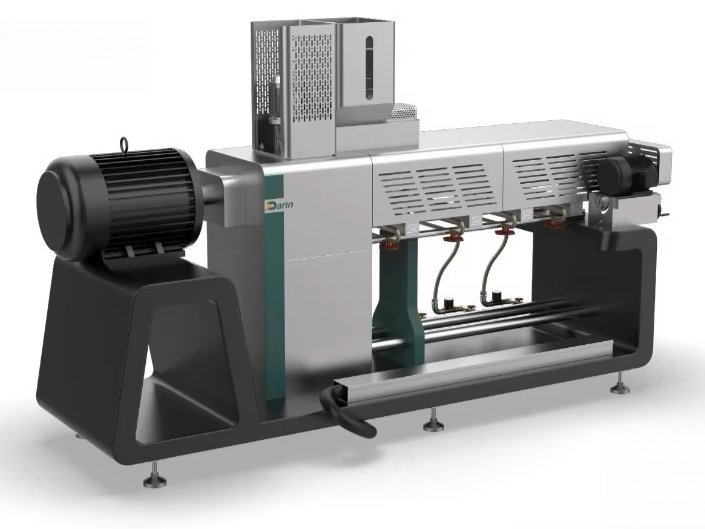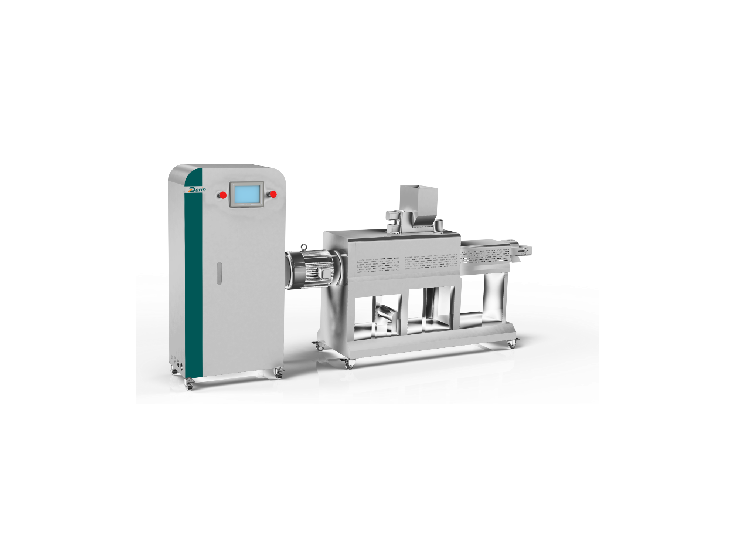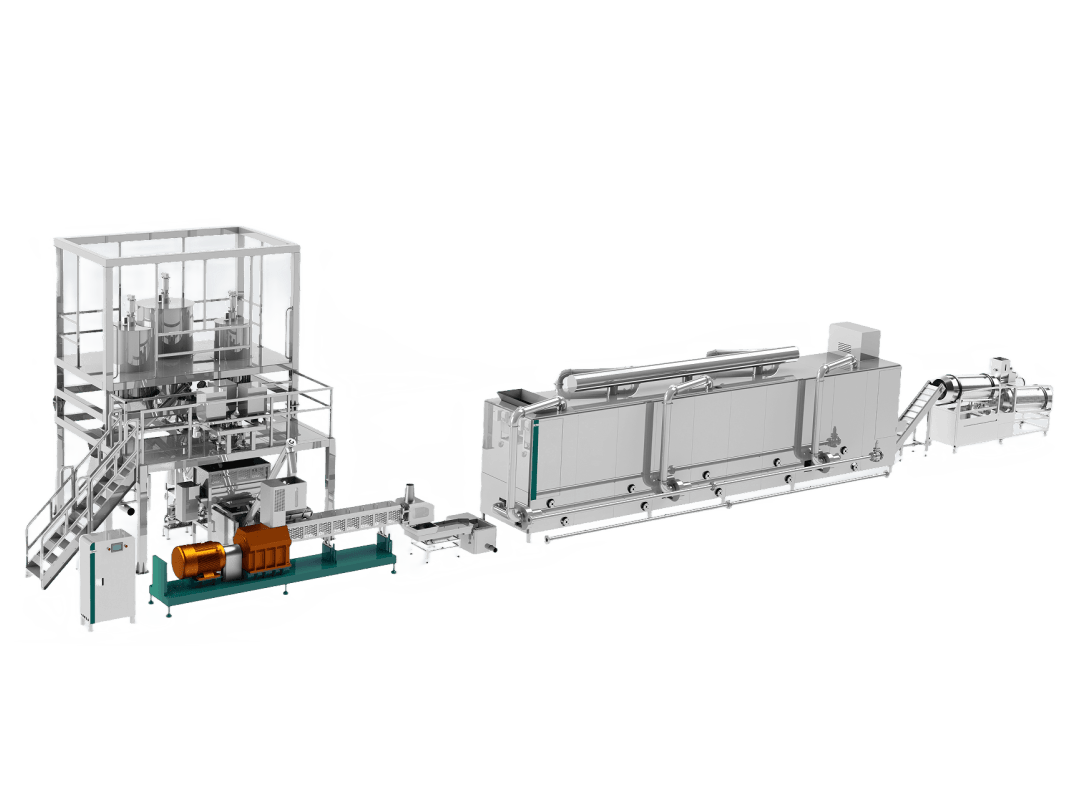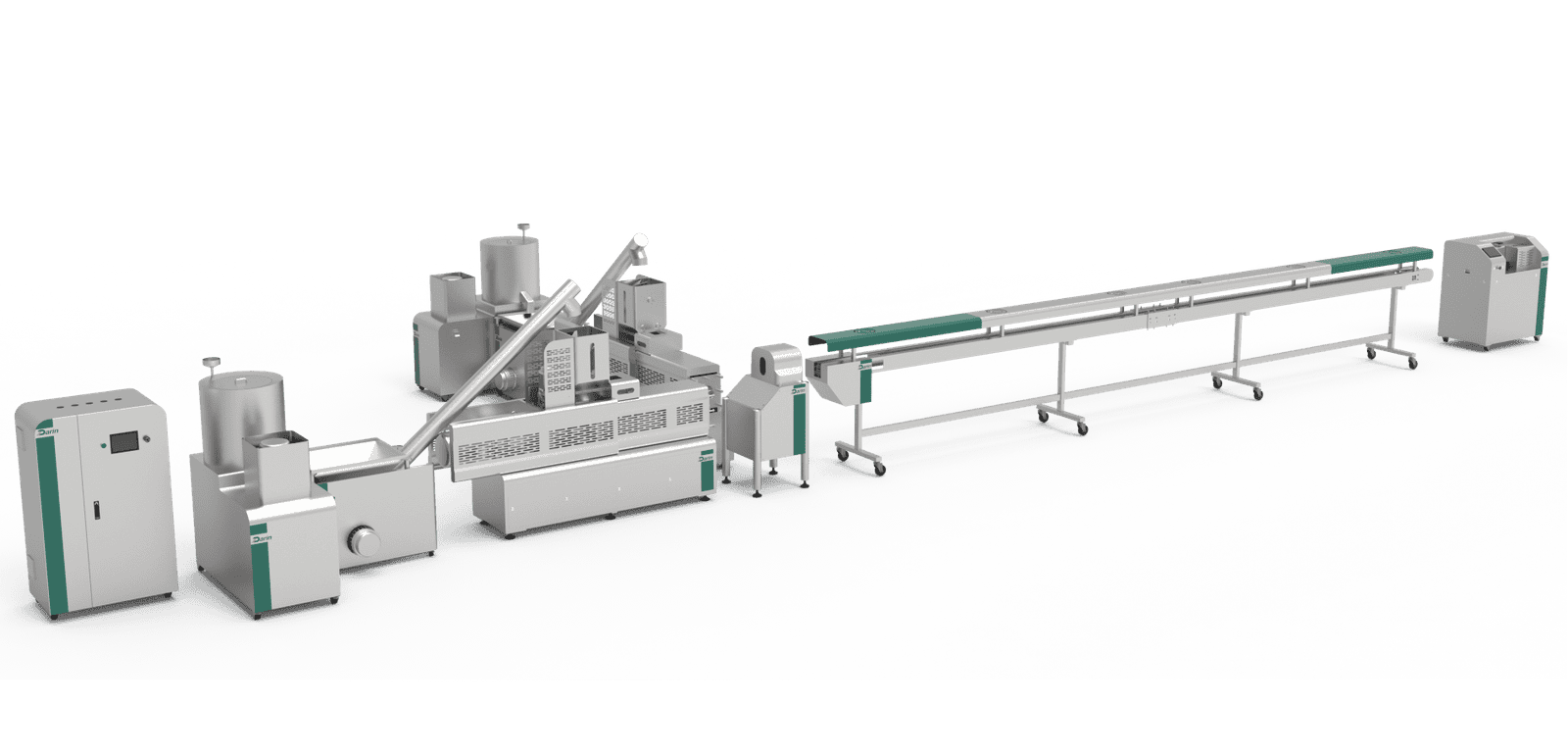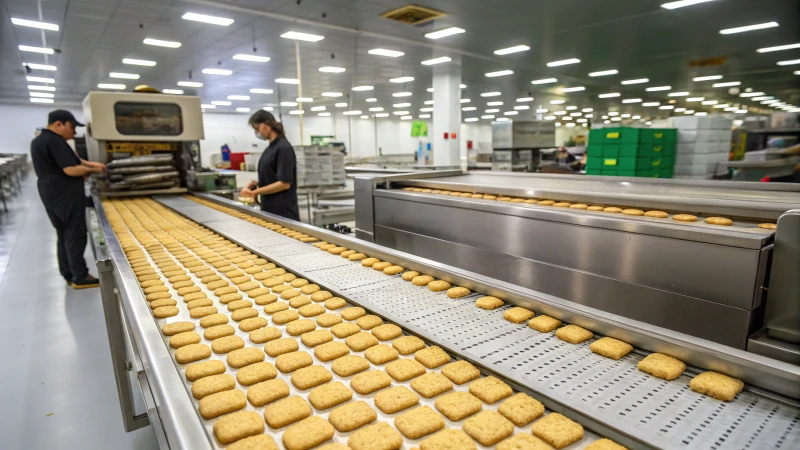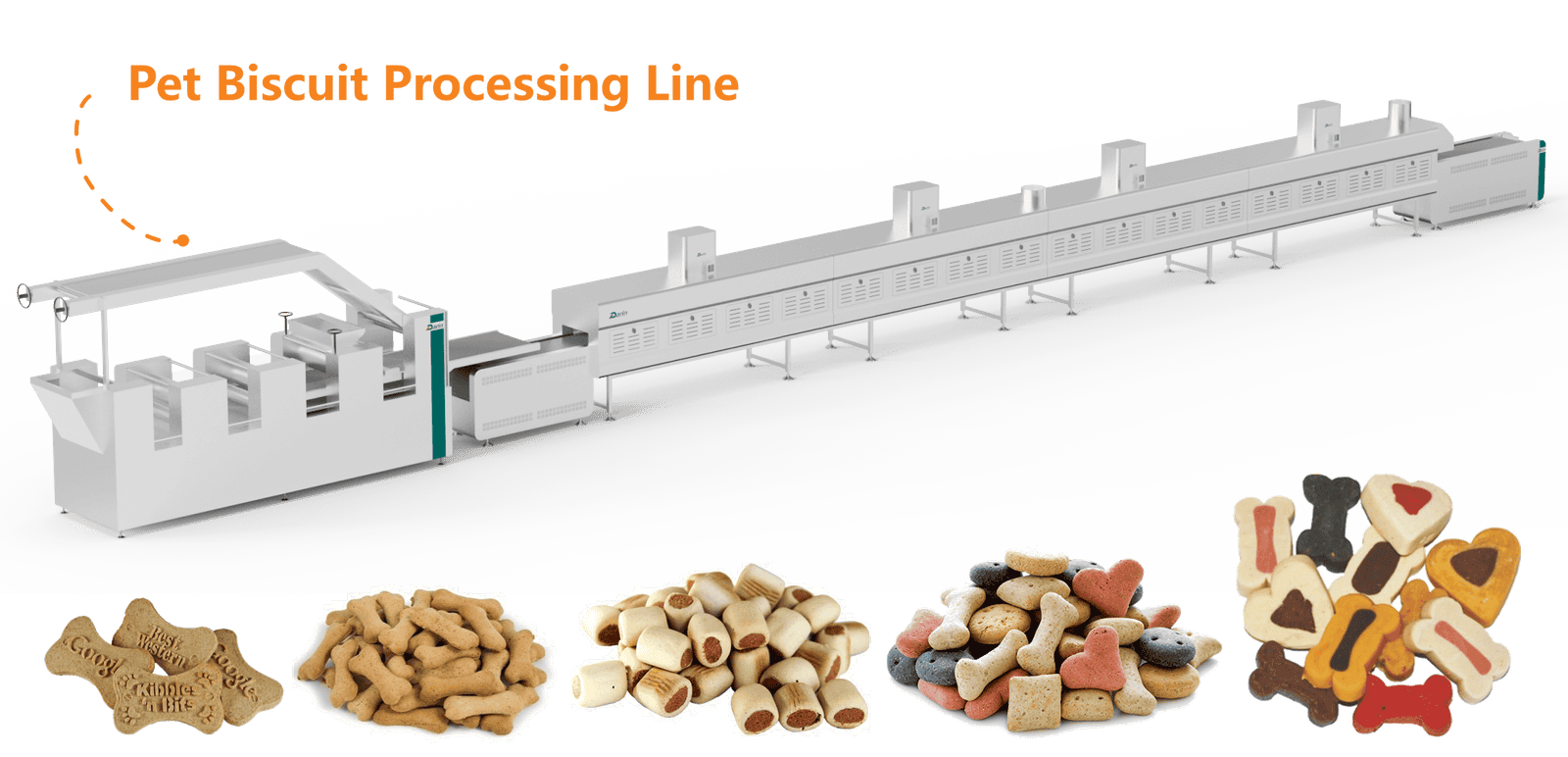
In commercial bakeries, the most expensive problems are texture drift (biscuits bake too hard or too pale), shape loss (spread, shrink, or cracks), and uneven moisture (staling or breakage during packing). These issues cascade into scrap, overtime, customer complaints, and retailer chargebacks. The solution is a purpose-built biscuit production line engineered for repeatable dough rheology, precise forming, zoned thermal profiles, controlled moisture loss, and hygienic automation from mixing to pack. Speaking both as a Ph.D. process engineer and as a manufacturer at Darin Machinery, I will map how a modern biscuit line is specified, how each unit operation works, and which parameters truly control color, bite, snap, and shelf life—so you can scale capacity with confidence and cut startup time on new SKUs.
A biscuit production line is an integrated, automated system that transforms ingredients into finished biscuits through sequential operations—ingredient handling, mixing, dough resting/tempering, forming (sheeting/lamination with rotary cutting; or wire-cutting; or rotary-moulding; or depositing), baking in a multi-zone tunnel oven, de-oiling (if applicable), cooling/equilibration, inline inspection, and primary/secondary packaging—coordinated by PLC/SCADA with recipe control of dough temperature, gauging roll gaps, moulding pressure, oven zone heat mode (top/bottom), belt speed, exhaust and humidity, and cooling time. It works by delivering a stable dough plasticity, shaping it accurately, applying controlled thermal energy to drive expansion and Maillard color, removing moisture to target a_w for shelf life, then cooling to avoid condensation and fracture before packaging.
If you’re comparing equipment or planning a plant extension, keep reading. Below you’ll find the end-to-end process, setpoint windows that actually keep shape and color in spec, energy and utility sizing, sanitation and changeover tactics, cost/ROI models, and troubleshooting checklists you can drop straight into a commissioning plan.
Direct gas-fired tunnel ovens are mandatory for all biscuit lines.False
Many biscuits bake excellently in indirect convection or hybrid ovens; DGF is common for color control but not mandatory.
Water activity (a_w) at packout is a stronger predictor of shelf life than moisture percentage alone for biscuits.True
Two biscuits with identical moisture can stale differently if a_w differs; packaging barrier selection is also based on a_w.
Biscuit categories and why process paths differ
Industrial “biscuits” include wire-cut cookies (short doughs with particulates), rotary-moulded biscuits (embossed, low-moisture short doughs), sheeted/laminated crackers (soda/savory), and deposited butter cookies. Each category prefers a specific forming path: wire-cut demands plastic, non-elastic doughs; rotary-moulded favors low hydration, high fat “short” dough; sheeted crackers need gluten development and laminated gas cells; deposited cookies require pumpable batters. Because physical chemistry differs (fat phase, sugar form, leavening system, gluten development, dough temperature), the line’s front-end (mixing, resting, forming) and oven profile are tailored accordingly. The “right” line is the one that locks down dough temperature and plasticity at the former, heat balance in the oven (top vs. bottom), and final a_w while protecting embossing detail and edge integrity.
End-to-end process flow (canonical routing)
- Ingredient receiving & QA → 2) Weighing/Batching (majors/minors) → 3) Mixing (short vs. developed dough regimes) → 4) Dough resting/tempering → 5) Forming route selection
• Sheeting/lamination → gauging → rotary cutting (crackers/cookies)
• Rotary-moulding (embossed biscuits)
• Wire-cut (soft inclusions)
• Depositing (butter/egg cookies) - Scrap return management → 7) Tunnel oven baking (multi-zone, hybrid heat) → 8) Post-oven cooling/equilibration → 9) Inline inspection (metal detection/X-ray; checkweigh) → 10) Primary packing (flow-wrap/tray) & secondary packing (carton/case)
Unit operations and “what good looks like” on a biscuit line
Ingredient handling and weighing
High-throughput lines rely on silos or super-sacks for flour and sugar with loss-in-weight feeders; minors (leavening, salt, flavors) weigh on precision scales with barcode confirmation for recipe integrity. Accuracy targets: ±0.2–0.5% for majors; ±0.1% for leavening agents. Segregate allergen ingredients. Pneumatic conveyance uses filtered air; magnets/sieves on lines protect against tramp metal and agglomerates.
Mixing (short vs. developed dough)
Two dominant regimes exist: short doughs (high fat/sugar, minimal gluten development) for wire-cut/rotary-moulded, and developed doughs (lower fat, more water, moderate gluten development) for crackers/sheeted items. For short dough: add fat/sugar first (creaming), then flour; keep dough temperature 18–22 °C to maintain plasticity. For developed dough: combine flour/water in a two-stage mix with rest (autolyse) to develop gluten; target 22–28 °C. Overheating increases stickiness and reduces embossing fidelity. Jacketed mixers, chilled water, and timed additions keep temperature in range.
Resting/tempering
Even 10–30 minutes of rest allows flour hydration and fat distribution; for laminated crackers, bulk fermentation or chemical leavening activation time is controlled to manage gas cells. Dough temperature equalization here avoids downstream gauging roll fouling.
Forming routes
- Sheeting & lamination (crackers/cut cookies): A set of breakdown and gauging rolls reduces sheet thickness progressively (e.g., 12 mm → 6 mm → 3 mm → 2 mm). Laminators fold layers (typically 8–16 layers) to build flaky structure. Rotary cutters (die + anvil) cut shapes; scrap is returned via conveyors—limit recycled scrap to ≤15–20% of dough mass to avoid textural drift.
- Rotary-moulding: A feed roll forces short dough into engraved cavities of a moulding roll; a doctor blade scrapes the surface; a transfer belt lifts molded pieces. Control variables: cavity fill (pressure differential), dough temperature, fat content.
- Wire-cut: A pump/extrusion head pushes dough through dies; a reciprocating wire slices pieces; ideal for inclusions (chips, nuts). Dough must be plastic yet non-elastic to prevent post-cut slump.
- Depositing: For pumpable batters, servo-driven depositors place dollops with or without nozzles that shape ridges.
Tunnel oven baking
Modern lines use multi-zone tunnel ovens (typically 28–60 m) with independent top/bottom heat. Heat modes include direct gas-fired (DGF), indirect convection, radiant, or hybrids. Early zones promote lift and set; middle zones drive moisture removal and Maillard; late zones finish color and stabilize structure. Control handles: setpoints for each zone, exhaust/damper positions (humidity), and belt speed. Typical core profile: 180–240 °C setpoints depending on product. Balance top/bottom to prevent “smiles” or “crowns.” Residence time ranges 3–8 minutes for cookies; 4–12 minutes for crackers, depending on thickness and formulation.
Cooling and equilibration
Biscuits exit the oven at 100–120 °C surface temperature and must cool to <35 °C before packing to avoid condensation and fracture. Multi-tier ambient or forced-air cooling conveyors (often 1–3× oven time) allow moisture to equilibrate across thickness. Target packout a_w commonly 0.20–0.45 for crisp items; 0.35–0.60 for softer cookies (ranges vary with SKU and region). Positive-pressure, filtered air in the cooling/packing zone reduces dust and re-contamination.
Inline inspection and packaging
Metal detection aperture is selected for product/package size (typical sensitivities around Fe 1.5 mm, non-Fe 2.0 mm, SS 2.5 mm for 200–300 g flow-wraps). Checkweighers enforce label compliance. Packaging films are chosen by OTR/MVTR vs. a_w and fat content; N₂ flushing reduces oxidation. For fragile biscuits, tray-loading with top-paper may be preferred over flow-wrap piles.
Key process windows (reference table you can adapt)
| Unit Operation | Typical Setpoint Window | Why It Matters | Instrumentation/Control |
|---|---|---|---|
| Dough temperature (short dough) | 18–22 °C | Plasticity for moulding/emboss | Jacketed mixer, chilled water dosing |
| Dough temperature (cracker) | 22–28 °C | Gluten development & sheetability | Jacketed mixer, RTDs |
| Gauging roll gaps | Progressive to final 2–4 mm | Thickness control, weight | Servo gap control, feeler checks |
| Rotary-moulding cavity fill | 85–100% | Emboss detail, weight | Feed roll speed, doctor blade gap |
| Oven early zones | 180–220 °C (top/bottom tuned) | Lift and set | Independent top/bottom control |
| Oven mid zones | 200–240 °C | Maillard, dehydration | Exhaust/damper %, dew-point proxy |
| Oven end zones | 160–200 °C | Color finish, internal dry | Zone PID, belt speed |
| Exit moisture / a_w | Moisture 1.5–4.5%; a_w 0.20–0.45 (crisp) | Shelf life, snap | a_w meter; inline NIR moisture |
| Cooling time | 1–3× oven residence | Avoid condensation, fracture | Ambient/forced air, temp probes |
Formulation levers and rheology (what actually moves texture and spread)
Flour protein (8–11% for cookies; 10–12% for crackers) sets potential gluten. Sugar form (granulated vs. powdered vs. invert) affects spread and color; invert increases browning and tenderness. Fat type and SFC (solid fat content) at dough temperature govern shortness and embossing. Water and egg content shift plasticity; leavening (bicarbonate/acid pairs) schedules CO₂ release. Salt tightens gluten and moderates spread. Emulsifiers (e.g., lecithin, SSL) aid dispersion. For wire-cut, higher fat and sugar with lower water create a non-elastic dough that cuts clean and spreads predictably; for rotary-moulded, lower water (12–18%) and moderate fat (\~16–24%) favor cavity release. For sheeted crackers, water (22–34%) and development time drive film strength for lamination.
Typical formulation envelopes (illustrative)
| Category | Flour | Fat | Sugar | Water | Leavening/Yeast | Salt/Minor |
|---|---|---|---|---|---|---|
| Rotary-moulded biscuit | 100 | 16–24 | 18–28 | 12–18 | 1.0–1.8 | 1.5–2.0 |
| Wire-cut cookie | 100 | 22–32 | 25–40 | 12–20 | 0.8–1.6 | 1.3–1.8 |
| Deposited butter cookie | 100 | 30–40 | 30–45 | 10–18 | 0.8–1.6 | 1.3–1.8 |
| Cracker (sheeted/laminated) | 100 | 6–12 (plus laminating fat) | 0–8 | 22–34 | 1.0–2.0 (or yeast 1–2) | 1.8–2.2 |
Values are baker’s % (flour=100). Exact ranges depend on style and market.
Automation architecture and data you should insist on
Modern lines run on PLCs with recipe management and SCADA/HMI. Critical loops include: mixer time/sequence and water temperature; sheeter roll gaps and speeds; scrap return ratio; moulding pressures; oven zone temperatures with independent top/bottom firing; exhaust/damper positions; belt speed; product surface temperature (IR) at zone exits; cooling zone temperatures; packer counts. A historian logging at 1–5 s granularity lets you compute energy per kg and correlate dough temperature drift with oven color. Use OPC UA tags and role-based access; keep golden batch fingerprints to detect drift.
Sizing the oven and utilities (worked example)
Suppose you want 1,000 kg/h of rotary-moulded biscuits leaving the cooler at 2.0% moisture, baked from dough at 16% moisture. Water to remove per kg finished ≈ (0.16–0.02)/(1–0.02) ≈ 0.1429 kg/kg. At 1,000 kg/h, evaporate \~143 kg/h. Effective heat per kg evaporated (including sensible, losses, humidity control) typically 2,500–3,000 kJ/kg; duty ≈ 357–429 MJ/h (≈99–119 kW thermal). Add inefficiencies and belt losses; a 36–42 m hybrid oven with staged zones is common. Electrical for drives/fans/infeed/outfeed may be 60–110 kW; cooling conveyors 10–30 kW. Compressed air (6–8 bar clean/dry) for actuators; gas or thermal oil for oven heat; HVAC with dehumidification in packing to keep a_w stable.
Quick specification snapshot (by nominal capacity)
| Finished Rate (kg/h) | Likely Oven Length (m) | Thermal Input (kW) | Electrical Load (kW) | Floor Space (m²) |
|---|---|---|---|---|
| 300 | 18–24 | 40–60 | 25–45 | 120–180 |
| 600 | 24–32 | 70–95 | 40–80 | 180–260 |
| 1,000 | 36–42 | 100–130 | 70–120 | 260–360 |
| 2,000 | 60–72 (dual lines) | 180–260 | 140–220 | 450–700 |
HACCP and prerequisite programs (biscuit-specific)
| Step | Biological | Chemical | Physical | Controls |
|---|---|---|---|---|
| Receiving | Ingredient contamination | Allergen cross-contact | Stones/metal | Supplier approval, COAs, sieves/magnets |
| Mixing | Warm holds permit growth | Improper leavening dosage | Foreign matter | Time/Temp, barcode verification, screens |
| Forming | Low | Lubricant contact | Metal fragments | Food-grade lubes, guarding, knife/wire checks |
| Baking | Lethality achieved | Acrylamide risk (excess browning) | — | Validated time/temperature; color control |
| Cooling | Recontamination if unfiltered | — | Dust | Positive-pressure, HEPA, sanitation |
| Packing | — | Film migration if wrong spec | Metal | Correct film grade, metal detection/X-ray |
Sanitation, allergen control, and changeover that protects OEE
Design lines with open profiles and minimal horizontal ledges; tool-less belt releases and removable scrapers reduce cleaning time. Dry-clean (vacuum, brush) pre-wet to limit slurry. For allergen changeovers (e.g., peanut to plain), validate with allergen swabs at worst-case harborage points (rotary-mould cavities, wire-cut heads, guides). Use COP (clean-out-of-place) tanks for small parts. Target flavor-to-flavor changeovers ≤2 h; allergen changeovers ≤6 h. Implement 5S kits and visual work instructions; these alone can lift OEE by 5–10 points.
Energy, emissions, and sustainability—savings that also stabilize product
Heat-recovery on oven exhaust can preheat make-up air, cutting gas use by 10–20%. Variable-speed drives on fans/belts match load; dew-point control stabilizes color with less over-baking. High-efficiency burners, IE3/IE4 motors, and on-demand N₂ for packing all reduce operating cost. Plan a staged shutdown to avoid thermal shock and cracking at oven exit.
Cost, TCO, and ROI (realistic bands)
CapEx varies by capacity and forming flexibility. A compact 300 kg/h rotary-moulded line (silos → mixer → moulder → 24 m hybrid oven → cooler → flow-wrap) may be USD 600k–1.1 m. A 1,000 kg/h flexible line with sheeting + rotary-moulding, 36–42 m oven, integrated cooling, and auto-pack can be USD 1.8–3.2 m. Annual maintenance typically 2–4% of CapEx; energy is the next largest OpEx after labor and packaging. At a gross margin of \$0.60–\$1.20/kg and 16 h/day utilization, simple payback can land in 12–24 months, depending on uptime and product mix.
A compact troubleshooting guide (symptom → root cause → fix)
| Symptom | Likely Causes | Fast Fix | Permanent Fix |
|---|---|---|---|
| Excess spread (cookies) | Dough too warm; fat too soft; low flour protein | Chill dough; reduce water 0.5–1%; increase belt speed | Reformulate fat SFC; adjust flour spec; mixer temperature control |
| Pale color | Low sugar/invert; oven early-zone too cool; high exhaust | Raise mid-zone temp; reduce exhaust; increase invert sugar | Re-balance leavening/sugar; install dew-point control |
| Top cracks (“checking”) | Case-hardening; too aggressive early heat | Lower first-zone top heat; increase humidity | Add hybrid zone; longer residence time |
| Poor emboss detail | Dough too warm/elastic; low fat | Reduce dough temp; increase fat slightly | Tighten moulding parameters; adjust flour/protein |
| Breakage in packing | Insufficient cooling; moisture gradient | Extend cooling; delay packout | Add cooling tiers; specify film stiffness and tray support |
Preventive maintenance you can lift into your CMMS
| Frequency | Tasks |
|---|---|
| Per shift | Inspect belts, scraper blades, roll gaps; verify critical sensors; color checks by camera or Lab*; metal detector test |
| Weekly | Lubricate bearings (food-grade), check doctor blades, verify exhaust dampers, calibrate checkweighers |
| Monthly | Thermal scan of MCCs; clean burner nozzles; NIR/moisture probe calibration; IR camera survey of oven seals |
| Quarterly | Overhaul rotary-mould cavities; check wire-cut head wear; airflow balance across zones |
| Annually | Rebuild gearboxes/rollers; replace belts as per wear; full HACCP and allergen validation refresh |
What distinguishes a Darin Machinery biscuit line in daily use
We design for control and maintainability: open frames, lift-off guards, tool-less belt access; hybrid ovens with independent top/bottom control per zone; dew-point and air-velocity sensing as standard; servo-controlled gauging rolls with digital recipes; scrap-return ratio control to keep texture stable across shifts. Our applications team characterizes your formulas, maps a dough temperature/plasticity window, and delivers a startup curve operators can trust. Commissioning includes a “golden batch” fingerprint of all tags so you can spot drift quickly.
Buyer’s RFP checklist (practical and complete)
- Target categories (rotary-moulded / wire-cut / deposited / sheeted-laminated) and Year-3 roadmap
- Dough temperature control strategy (jacketed mixer, chilled water setpoints)
- Forming modules (quick-change tooling, cavity sets, wire-cut dies)
- Oven type (DGF / indirect / hybrid), number of zones, independent top/bottom control, exhaust control strategy
- Color control (camera feedback? Lab* target ranges?)
- Moisture/a_w control (inline NIR? sampling frequency?)
- Cooling conveyor length and filtration/pressure cascade into packing
- Sanitation design (open profiles, COP lists, allergen changeover validation)
- Automation openness (OPC UA tag list, historian ownership)
- After-sales (spares list, SLA, remote support, training)
Mini case: 1,200 kg/h rotary-moulded + wire-cut combo
A customer required embossed sandwich biscuits and chocolate-chip cookies on the same line. We installed dual forming heads feeding a shared 40 m hybrid oven with nine zones, camera-based color monitoring, and dew-point control. Scrap return was capped at 15% with automatic ratio logging. Changeover (moulder ↔ wire-cut) averaged 75 minutes. OEE climbed from 62% in month one to 76% by month four after roll-gap standardization and golden-batch adoption.
Practical QA plan (from startup to steady state)
Start with Process Capability targets: weight Cpk ≥1.33, color ∆E ≤2.0 vs. master, moisture ±0.3 pp, a_w ±0.02, breakage ≤1.0% at pack, metal detector performance verified per shift. Sampling: weight every 15 minutes; color and moisture every 30–60 minutes; a_w every 2–4 hours until stable, then shift-wise. Retain samples daily by lot and perform accelerated shelf-life checks weekly.
Training and documentation that stick
Provide role-specific SOPs: mixer settings and temp checks; forming head changeover; oven zone adjustments for seasonal humidity; cooling conveyor hygiene; packer film change and seal checks. Visual one-page guides at each HMI reduce errors. Train on root-cause tools (5 Whys, fishbone) and empower operators to pause for parameter drift beyond pre-set bands.
Implementation roadmap (phased and realistic)
- Process definition & pilot—validate formulations on a test line, define dough temp windows and oven curves.
- Capital spec & FAT—approve GA drawings, I/O lists, safety validation, and dry thermal mapping.
- SAT & ramp-up—run witness lots, capture golden batch, coach operators.
- Stabilization—close gaps vs. KPIs, lock preventive maintenance, finalize changeover standards.
- Optimization—energy recovery tuning, color camera feedback, scrap return optimization.
Summary—what to remember when you choose or upgrade a biscuit line
If you remember just three things, make them these: (1) control dough temperature and plasticity at the forming station; (2) specify a multi-zone oven with independent top/bottom heat and exhaust control; and (3) design cooling and packing environments to protect a_w and structure. Do those consistently and you’ll hold color, bite, and yield—and your line will run like a metronome.
Talk to Darin Machinery (let’s make this easy)
Want a no-nonsense layout, capacity sizing, and a startup curve tuned for your recipes? We’ll map your SKUs, validate the forming route, and deliver a commissioning plan your team can run from day one.
Email: darin4@darin.cn
Website: https://petreatsmachine.com/
Tell us your top three biscuit styles, target throughput, and available utilities, and we’ll sketch a tailored line and ROI model you can take to your stakeholders.
